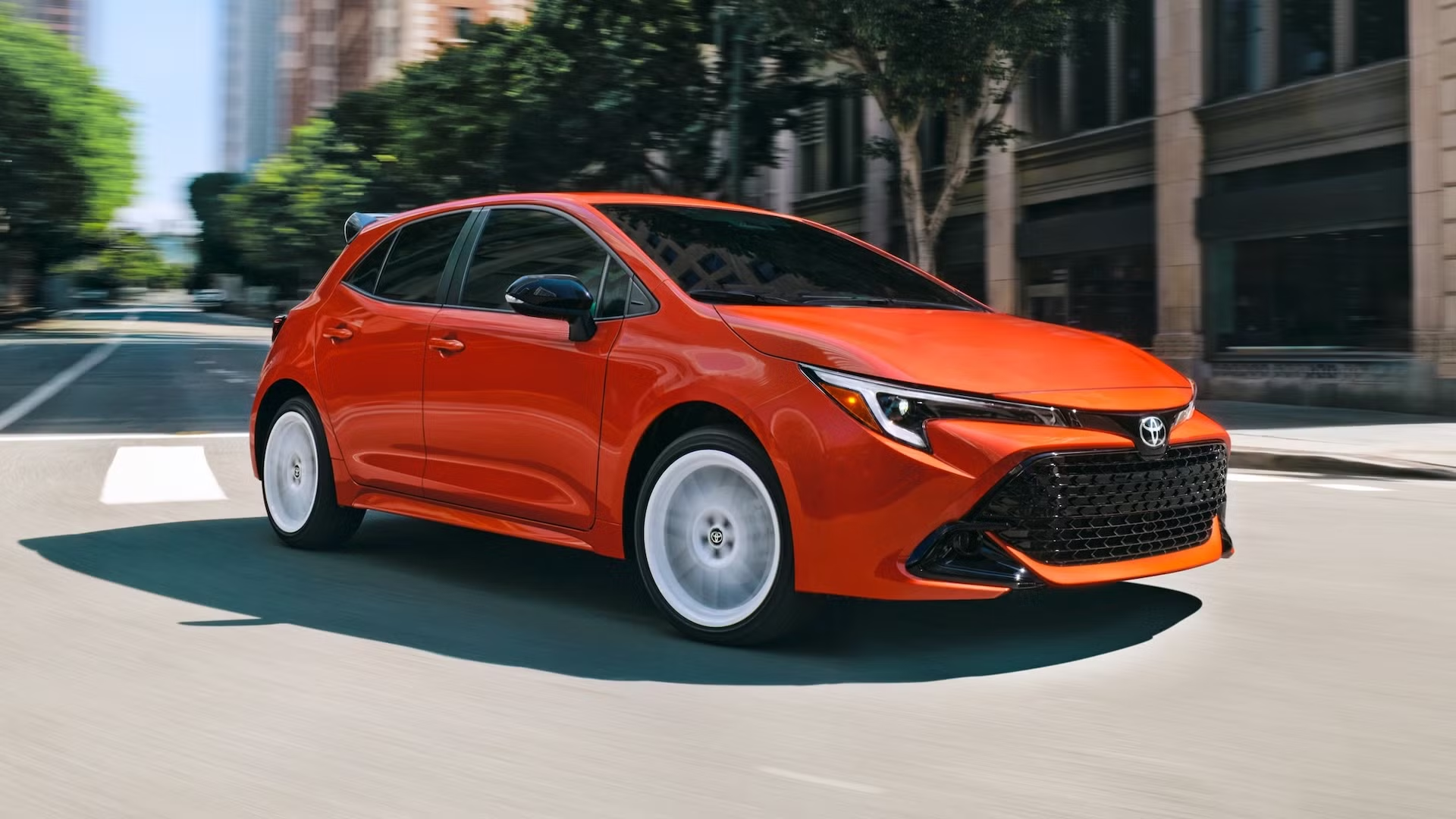In today’s automotive market, compact cars have become increasingly popular for their fuel efficiency, maneuverability, and affordability. However, many consumers hesitate to downsize from larger vehicles due to concerns about cargo capacity, particularly when it comes to accommodating full-size luggage for travel.
Fortunately, automakers have recognized this dilemma and engineered innovative solutions to maximize trunk space in smaller footprints.
Modern compact cars now feature thoughtfully designed cargo areas with expandable configurations, hidden storage compartments, and optimized dimensions that defy their exterior proportions.
This guide highlights ten standout compact cars that offer surprisingly generous trunk space, proving that downsizing doesn’t necessarily mean compromising on practicality.
Whether you’re a frequent traveler, a weekend adventurer, or simply someone who values versatility in a smaller vehicle, these models demonstrate that compact dimensions and ample luggage capacity are no longer mutually exclusive.
Each vehicle showcases unique approaches to space optimization while maintaining the efficiency and convenience that make compact cars so appealing.
1. Honda Civic
The Honda Civic stands as a masterclass in compact car design that refuses to compromise on cargo capacity. The latest generation boasts an impressive 14.8 cubic feet of trunk space in the sedan variant, numbers that rival some midsize sedans.
This engineering feat is achieved through Honda’s thoughtful approach to vehicle architecture, where every millimeter is maximized for utility without sacrificing the car’s sleek external proportions.
What makes the Civic’s trunk particularly remarkable is its practical shape. Unlike some competitors with awkward protrusions or narrow openings, the Civic features a wide, rectangular cargo area with minimal wheel well intrusion.
This thoughtful design allows for efficient packing of full-size suitcases side by side, a feature frequent travelers will appreciate. The trunk opening itself deserves mention wide and low, it eliminates the struggle of lifting heavy luggage over a high lip or maneuvering through a restrictive aperture.
Honda enhances this spaciousness with clever storage solutions. The trunk floor conceals a separate compartment perfect for keeping smaller items organized and preventing them from sliding around.
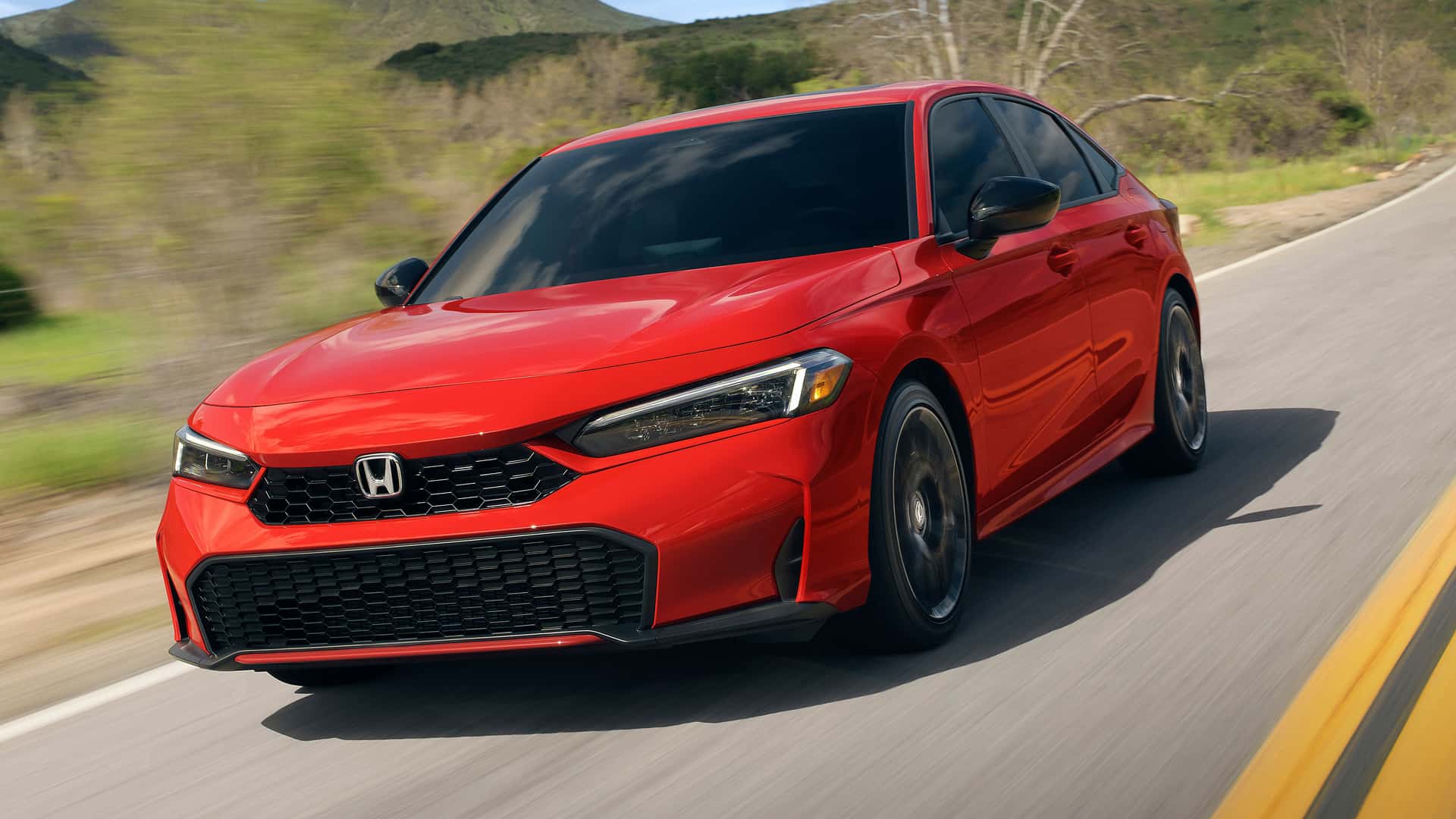
This thoughtful touch speaks to Honda’s attention to real-world usability rather than just impressive specification numbers. For those needing even more versatility, the Civic’s 60/40 split-folding rear seats expand the available cargo area substantially.
The seat release mechanisms are accessible from the trunk itself a convenience that eliminates the need to walk around to the passenger compartment when loading longer items. When folded, the seats create a nearly flat load floor, further enhancing the car’s utility for transporting larger items.
The hatchback version of the Civic takes cargo versatility to another level with up to 24.5 cubic feet behind the rear seats. This configuration transforms the compact Civic into a surprisingly capable hauler, accommodating multiple full-size suitcases with room to spare.
The hatchback’s wide opening and low load floor make it particularly suitable for awkward or bulky items that might challenge a traditional sedan trunk. Despite its impressive cargo capabilities, the Civic maintains excellent fuel efficiency a critical factor for many compact car buyers.
This combination of practicality and economy makes it an ideal choice for those who regularly travel but don’t want the expense or parking challenges associated with larger vehicles.
2. Mazda3
The Mazda3 exemplifies the perfect marriage between sophisticated design and practical functionality in the compact car segment. Available in both sedan and hatchback configurations, the Mazda3 offers impressive trunk capacity without sacrificing the sleek, premium aesthetics that have become Mazda’s signature.
The sedan variant provides 13.2 cubic feet of trunk space, while the hatchback significantly expands this to 20.1 cubic feet behind the rear seats, an impressive figure that belies the vehicle’s compact exterior dimensions.
What truly distinguishes the Mazda3’s cargo area is its thoughtfully engineered design. The trunk features a wide, square shape with minimal intrusions, allowing for efficient utilization of the available space.
The opening is generously proportioned, eliminating the common struggle of maneuvering bulky suitcases through narrow apertures. This practical approach extends to the trunk’s depth, which accommodates full-size luggage in a vertical orientation, a capability often lacking in compact vehicles.
Mazda’s attention to detail is evident in the quality of the trunk’s finishes. Unlike some competitors that leave trunk interiors as an afterthought with exposed metal or rough carpeting, the Mazda3 features premium materials and thoughtful touches like bag hooks and tie-down points.
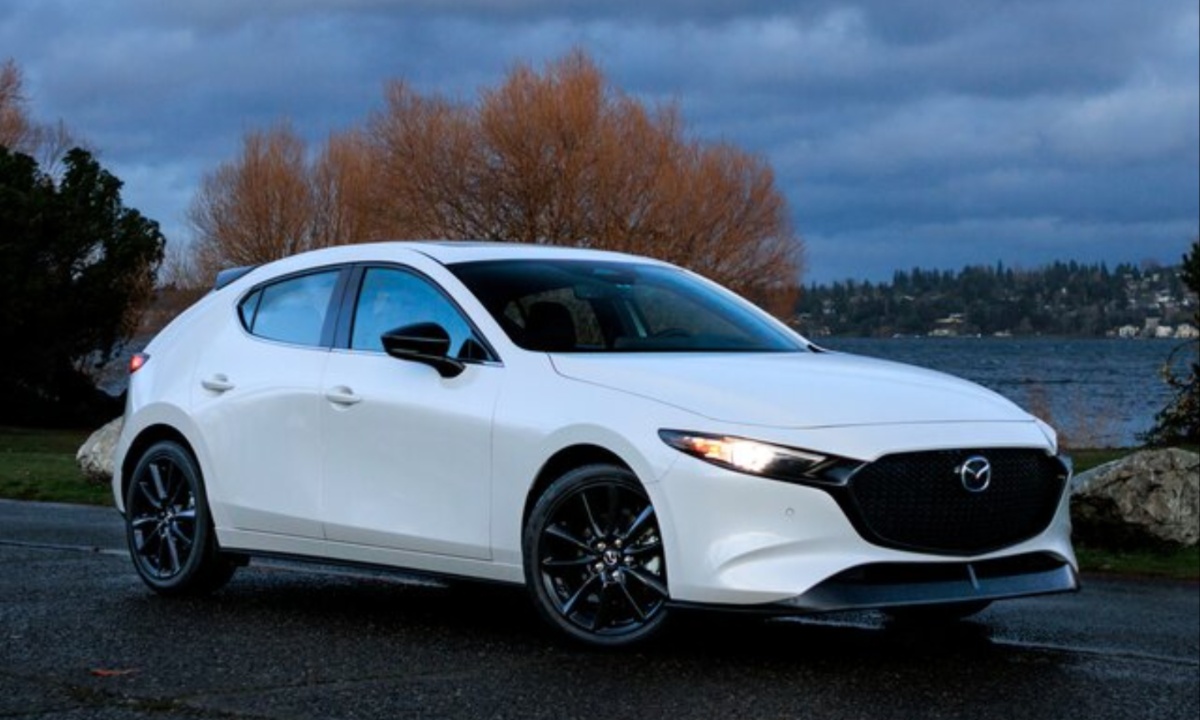
The trunk lid itself opens to a generous height, preventing taller users from having to stoop when loading and unloading luggage. The versatility of the Mazda3’s cargo capabilities shines through its intelligent seating configuration.
The rear seats split in a 60/40 arrangement and fold nearly flat, creating a continuous load floor when expanded cargo capacity is needed. This flexibility allows owners to transport a combination of passengers and larger items without compromise.
In the hatchback model, this expanded capacity reaches an impressive 47.1 cubic feet with the rear seats folded rivaling some small crossovers. Mazda enhances this practicality with smart features like an adjustable cargo floor in the hatchback variant.
This system allows owners to create a perfectly flat load area when the rear seats are folded, or to maximize depth when needed for taller items. A retractable cargo cover comes standard, providing security and privacy for valuables stored in the trunk particularly important for travelers who might need to leave luggage in the car temporarily.
Despite its impressive cargo capabilities, the Mazda3 maintains the dynamic driving experience and fuel efficiency expected from a compact car. This balance of practicality and performance makes it an exceptional choice for drivers who require substantial luggage capacity but aren’t willing to compromise on driving enjoyment or exterior aesthetics.
3. Volkswagen Golf
The Volkswagen Golf has cultivated a legendary reputation for maximizing interior space within compact exterior dimensions, and its trunk capacity stands as a testament to this engineering philosophy.
Though classified as a compact car, the Golf’s cargo area delivers utility that rivals many larger vehicles. In its standard configuration, the Golf offers 17.4 cubic feet of cargo space behind the rear seats, significantly more than many compact sedans and even some larger vehicles in its class.
The Golf’s trunk design exemplifies German practicality with its square, boxy shape that maximizes usable space. This thoughtful approach eschews stylistic curves and contours that might look appealing but reduce functional capacity.
The result is a cargo area that accommodates full-size luggage with remarkable efficiency, allowing for strategic packing that utilizes every available inch.
The wide hatch opening further enhances accessibility, making loading large suitcases a straightforward process rather than a frustrating puzzle. Volkswagen’s engineering prowess is particularly evident in the Golf’s variable cargo floor.
This innovative feature can be positioned at different heights to suit various needs, raise it for a flat load area when the rear seats are folded, or lower it to maximize vertical space for taller items.
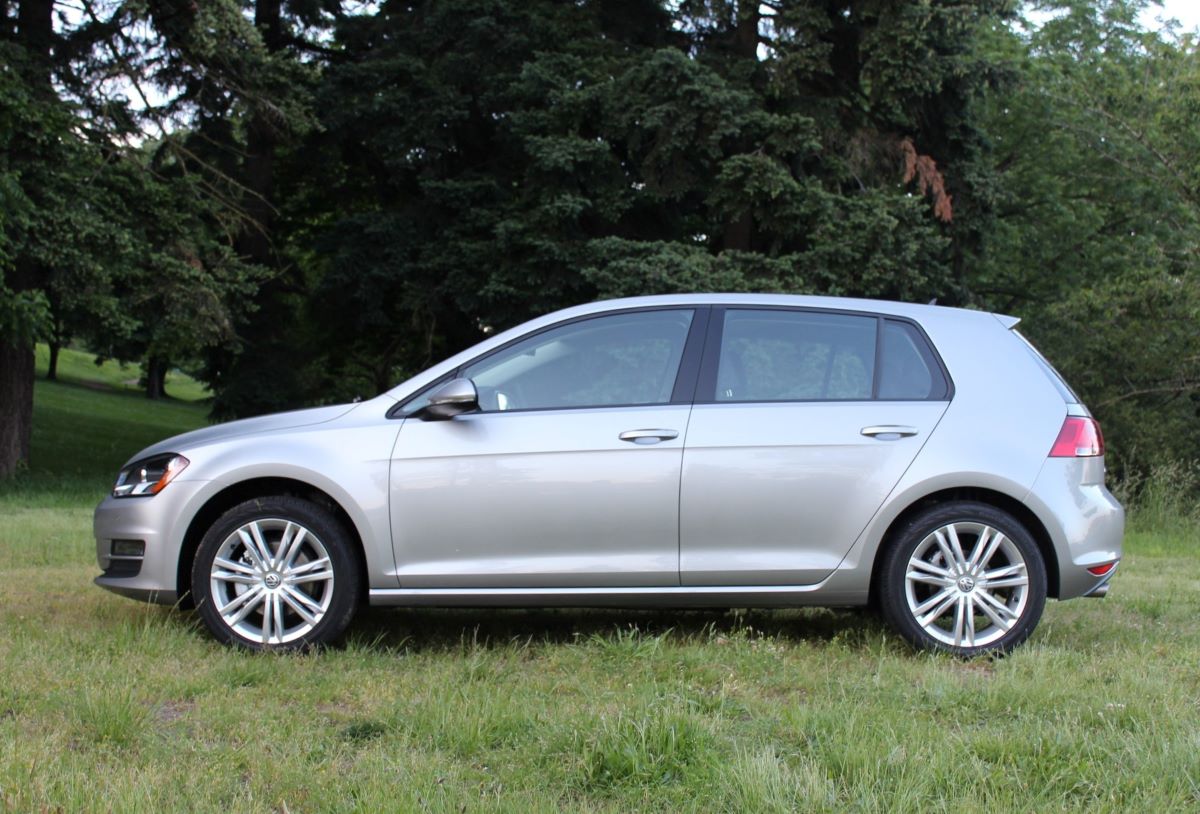
Beneath this floor lies additional storage compartments perfect for keeping smaller travel essentials organized and secure. These hidden spaces prove invaluable for storing valuables or emergency items that don’t need frequent access.
The Golf’s rear seats split in a practical 60/40 configuration and fold nearly flat, expanding the cargo capacity to an impressive 53.7 cubic feet. This transformation effectively converts the compact hatchback into a small wagon, capable of handling luggage for extended family trips or bulky items that would challenge many larger vehicles.
The folding mechanism is engineered for effortless operation, requiring minimal effort to switch between passenger and cargo configurations. Volkswagen has enhanced the Golf’s trunk with thoughtful details that elevate the ownership experience. Integrated bag hooks prevent groceries and other items from sliding around during transit.
Tie-down points offer security for larger items, while strategic lighting ensures visibility when loading or unloading in low-light conditions. The cargo cover retracts smoothly when not needed and provides security when deployed a consideration particularly important for travelers who might leave luggage in the vehicle.
Despite its impressive cargo capabilities, the Golf maintains the efficient footprint and nimble handling that make compact cars so appealing for urban environments.
This combination of generous storage capacity and city-friendly dimensions makes it an ideal choice for those who require substantial luggage space without the parking challenges and fuel consumption associated with larger vehicles.
4. Toyota Corolla Hatchback
The Toyota Corolla Hatchback represents a significant evolution in Toyota’s approach to compact car design, balancing the nameplate’s renowned reliability with enhanced practicality and style.
While the Corolla sedan offers respectable trunk space at 13.1 cubic feet, the hatchback configuration elevates this capacity to 17.8 cubic feet behind the rear seats a substantial increase that transforms the vehicle’s utility for travelers and active lifestyles.
What makes the Corolla Hatchback’s trunk particularly impressive is its thoughtful design optimization. Toyota’s engineers have crafted a cargo area with minimal intrusions and a wide, flat floor that accommodates multiple full-size suitcases with efficient space utilization.
The hatchback opening itself deserves special mention exceptionally wide and tall, it eliminates the common frustration of trying to maneuver bulky items through restrictive apertures.
This design consideration makes loading and unloading luggage remarkably straightforward, even for larger or irregularly shaped items. Toyota has enhanced the Corolla Hatchback’s cargo versatility with a dual-level adjustable cargo floor.
This innovative feature can be positioned higher to create a flat load surface when the rear seats are folded, or lower to maximize vertical space for taller items.

In its lower position, the increased height clearance allows for items like upright carry-on luggage or tall shopping bags that might otherwise need to be laid flat. This flexibility proves invaluable for real-world usage scenarios where cargo needs can vary significantly from day to day.
The 60/40 split-folding rear seats expand the Corolla Hatchback’s utility substantially, creating up to 23.3 cubic feet of cargo space when fully folded. While this figure might appear modest compared to some competitors, the Corolla compensates with exceptionally thoughtful execution.
The seats fold nearly flat with minimal effort, creating a continuous load floor that’s ideal for longer items or maximizing packing efficiency on extended trips.
The transition between passenger and cargo configurations is seamless, requiring no complex mechanisms or removal of headrests. Toyota has incorporated numerous practical details that enhance the functionality of the Corolla Hatchback’s cargo area.
Integrated tie-down points prevent luggage from shifting during transit, while strategic lighting ensures visibility when loading or unloading at night.
A retractable cargo cover comes standard, providing security and privacy for valuables, particularly important for travelers who might need to leave luggage in the vehicle temporarily. The cover’s design allows for quick removal when transporting taller items.
Despite its impressive cargo capabilities, the Corolla Hatchback maintains excellent fuel efficiency a critical consideration for many compact car buyers.
This combination of practicality and economy makes it an ideal choice for those who regularly travel but don’t want the expense or parking challenges associated with larger vehicles.
The Corolla Hatchback proves that compact dimensions and substantial luggage capacity can coexist in a thoughtfully designed package.
Also Read: 10 Car Models That Their Own Brands Abandoned
5. Subaru Impreza
The Subaru Impreza stands as a compelling example of how intelligent engineering can create surprising cargo capacity within compact dimensions.
Available in both sedan and hatchback configurations, the Impreza offers versatile storage options that exceed expectations for its class. The sedan provides a respectable 12.3 cubic feet of trunk space, while the hatchback significantly expands this capacity to 20.8 cubic feet behind the rear seats, an impressive figure that rivals some small SUVs.
What truly distinguishes the Impreza’s cargo area is its thoughtfully optimized design. Subaru has engineered a trunk with minimal intrusions and a wide, flat floor that maximizes usable space.
In the hatchback variant, the square, boxy shape of the cargo area allows for efficient packing of full-size luggage, with dimensions that accommodate suitcases in both horizontal and vertical orientations.
This flexibility proves invaluable when Tetris-ing multiple bags into the available space. The Impreza’s wide hatch opening deserves special mention, designed to span nearly the entire width of the vehicle’s rear, it eliminates the common struggle of maneuvering bulky items through restrictive apertures.
The loading lip sits at a comfortable height, reducing the effort required to lift heavy luggage into the cargo area. These thoughtful considerations demonstrate Subaru’s understanding of real-world usability rather than just impressive specification numbers.
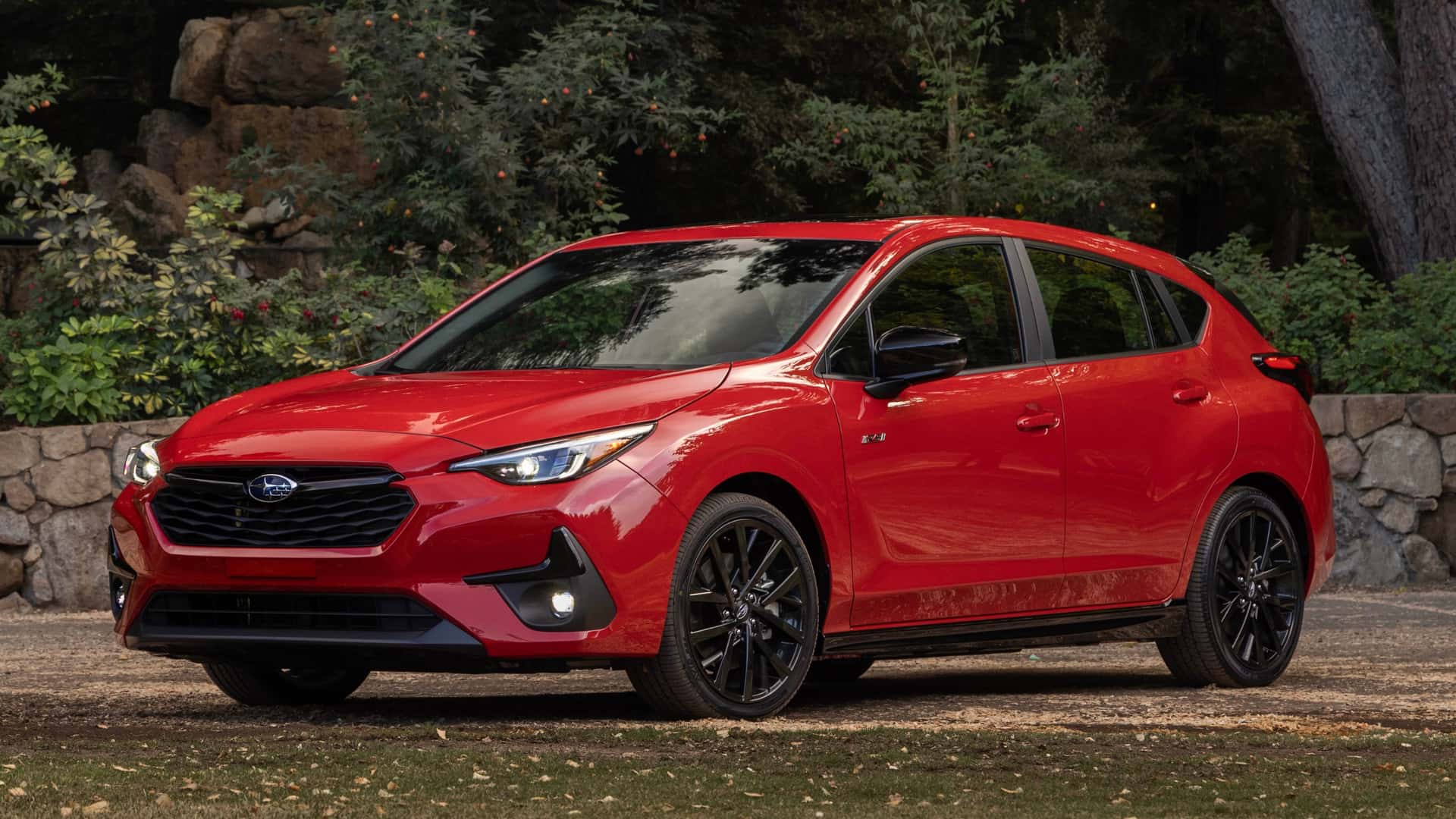
Subaru enhances the Impreza’s versatility with 60/40 split-folding rear seats that create an expansive 55.3 cubic feet of cargo space when fully folded in the hatchback model.
The seats fold nearly flat with minimal effort, creating a continuous load floor ideal for longer items or maximizing packing efficiency on extended trips.
The transition between passenger and cargo configurations is seamless, requiring no complex mechanisms or removal of headrests a convenience often overlooked in competitive models.
A standout feature of the Impreza is its standard all-wheel drive system, unique in the compact car segment. This capability adds another dimension to the vehicle’s practicality, ensuring reliable transportation regardless of weather conditions.
For travelers who frequently visit areas with inclement weather or venture to ski resorts and other outdoor destinations, this combination of all-weather capability and generous cargo capacity proves invaluable.
Subaru has incorporated numerous practical details that enhance the functionality of the Impreza’s cargo area. Integrated tie-down points prevent luggage from shifting during transit, while a retractable cargo cover in the hatchback provides security and privacy for valuables.
The cargo floor features durable materials that withstand the wear and tear associated with frequent loading and unloading of heavy items a consideration particularly important for active lifestyles.
Despite its impressive cargo capabilities and all-wheel drive system, the Impreza maintains competitive fuel efficiency a critical consideration for many compact car buyers.
This combination of practicality, capability, and economy makes it an exceptional choice for those who require substantial luggage capacity without sacrificing the benefits associated with compact dimensions.
6. Kia Forte
The Kia Forte exemplifies how thoughtful design can maximize cargo space in a compact sedan footprint. With a trunk capacity of 15.3 cubic feet, the Forte boasts one of the most generous cargo areas in its class, surpassing many competitors and even rivaling some midsize sedans.
This impressive figure isn’t merely a result of creative measurement techniques but reflects genuinely usable space that accommodates full-size luggage with remarkable efficiency.
What makes the Forte’s trunk particularly noteworthy is its thoughtfully optimized shape. Kia’s engineers have created a cargo area with minimal intrusions and a wide, flat floor that allows for strategic packing of multiple suitcases.
The trunk opening itself deserves special mention, exceptionally wide and tall for a compact sedan, it eliminates the common frustration of trying to angle bulky items through restrictive apertures.
This design consideration makes loading and unloading luggage remarkably straightforward, even for larger or irregularly shaped items. Kia enhances the Forte’s versatility with 60/40 split-folding rear seats that expand the cargo capacity substantially when needed.
These seats fold nearly flat with minimal effort, creating a continuous load floor that’s ideal for longer items or maximizing packing efficiency on extended trips.
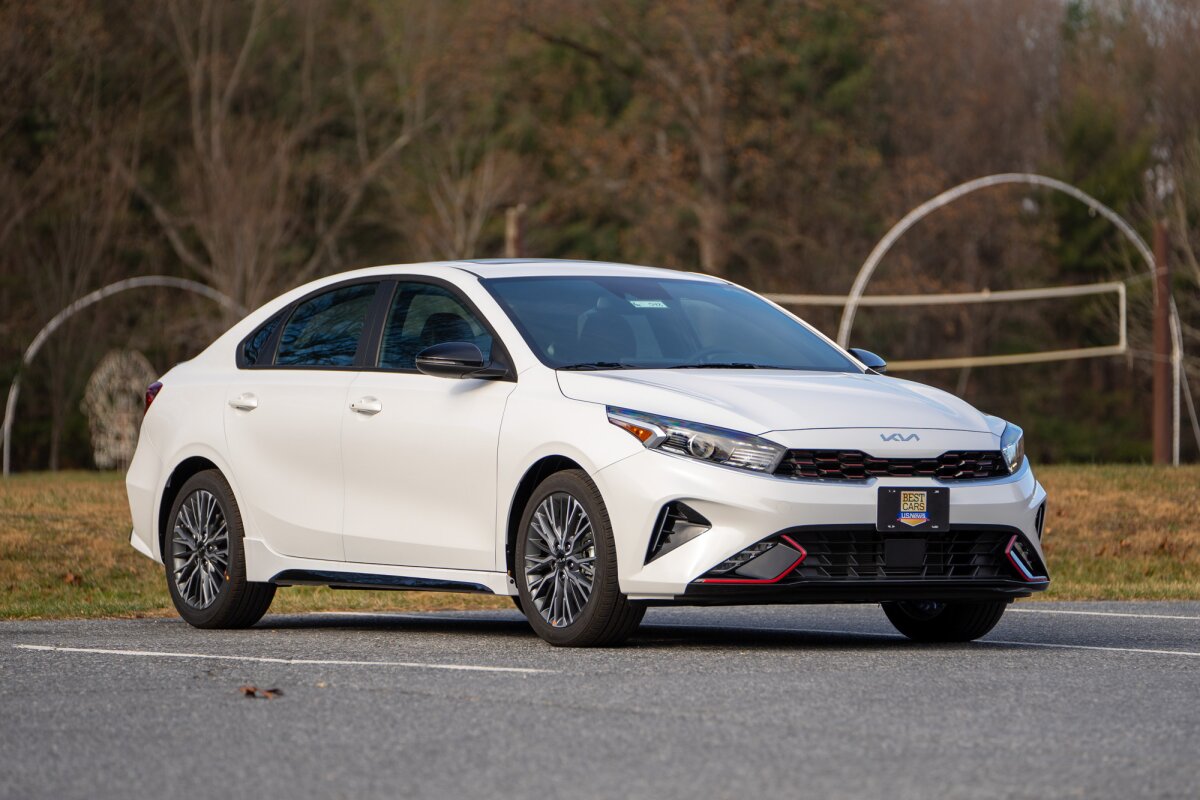
The seat release mechanisms are accessible from the trunk itself a convenience that eliminates the need to walk around to the passenger compartment when loading longer items.
The Forte’s trunk incorporates numerous practical details that enhance its functionality for travelers. A low lift-over height reduces the effort required to load heavy suitcases, while strategic lighting ensures visibility when loading or unloading at night.
The trunk lid opens to a generous height, preventing taller users from having to stoop when accessing the cargo area a consideration often overlooked in competitive models.
Kia has designed the Forte’s trunk with thoughtful storage solutions that maximize organization. The side walls feature small compartments perfect for keeping smaller items secure and preventing them from sliding around during transit.
The trunk floor conceals a spare tire without sacrificing cargo space, an engineering achievement that speaks to Kia’s commitment to practical efficiency. Despite its impressive cargo capacity, the Forte maintains excellent fuel efficiency,y a critical consideration for many compact car buyers.
This combination of practicality and economy makes it an ideal choice for those who regularly travel but don’t want the expense or parking challenges associated with larger vehicles.
The Forte’s competitive pricing further enhances its value proposition, offering premium cargo capacity without a premium price tag. Kia’s attention to detail extends to the quality of the trunk’s finishes.
Unlike some competitors that leave trunk interiors as an afterthought with exposed metal or rough carpeting, the Forte features premium materials and thoughtful touches like bag hooks and a cargo net.
These refinements elevate the ownership experience and demonstrate Kia’s understanding that cargo functionality involves more than just raw volume.
7. Hyundai Elantra
The Hyundai Elantra demonstrates remarkable engineering prowess in maximizing cargo capacity within compact sedan dimensions. With a trunk volume of 14.2 cubic feet, the Elantra offers expansive luggage space that belies its exterior proportions and establishes it as a standout option in its class.
This impressive capacity isn’t merely a statistical achievement but translates to genuine usability for travelers and everyday hauling needs. What distinguishes the Elantra’s trunk is its thoughtfully optimized configuration.
Hyundai’s engineers have crafted a cargo area with minimal intrusions and a wide, flat floor that accommodates multiple full-size suitcases with efficient space utilization.
The trunk’s dimensions have been carefully calculated to accommodate standard luggage sizes, allowing for strategic packing that maximizes the available space.
This attention to real-world usage scenarios reflects Hyundai’s understanding that trunk capacity isn’t just about volume measurements but about practical functionality.
The Elantra’s trunk opening deserves special mention, exceptionally wide for a compact sedan, it eliminates the common frustration of trying to angle bulky items through restrictive apertures.

The loading lip sits at a comfortable height, reducing the effort required to lift heavy luggage into the cargo area. These thoughtful considerations demonstrate Hyundai’s commitment to user-centered design rather than just impressive specification numbers.
Hyundai enhances the Elantra’s versatility with 60/40 split-folding rear seats that expand the cargo capacity substantially when needed. Unlike some competitors with awkward folding mechanisms or partial obstruction when folded, the Elantra’s seats create a nearly flat extended cargo floor.
This thoughtful execution makes the transition between passenger and cargo configurations seamless, requiring no complex operations or removal of headrests a convenience often overlooked in competitive models.
The Elantra’s trunk incorporates numerous practical details that enhance its functionality. Strategic lighting ensures visibility when loading or unloading at night, while the trunk lid opens to a generous height and features hydraulic struts for smooth operation.
The interior of the trunk is finished with durable materials that withstand the wear and tear associated with frequent loading and unloading of heavy items a consideration particularly important for active lifestyles.
Hyundai has designed the Elantra’s trunk with thoughtful storage solutions that maximize organization. The trunk floor conceals a full-size spare tire without sacrificing cargo space an engineering achievement that speaks to Hyundai’s commitment to practical efficiency.
In some trim levels, the Elantra offers a hands-free smart trunk release that automatically opens when the key fob is detected nearby for several seconds a convenience particularly appreciated when approaching the vehicle with arms full of luggage.
Despite its impressive cargo capacity, the Elantra maintains excellent fuel efficiency, a critical consideration for many compact car buyers. This combination of practicality and economy makes it an ideal choice for those who regularly travel but don’t want the expense or parking challenges associated with larger vehicles.
The Elantra’s competitive pricing and industry-leading warranty further enhance its value proposition, offering premium cargo capacity with long-term peace of mind.
8. Nissan Sentra
The Nissan Sentra exemplifies how thoughtful redesign can transform a compact sedan into a surprisingly capable luggage carrier.
With a trunk capacity of 14.3 cubic feet, the latest generation Sentra offers one of the most generous cargo areas in its class, a significant improvement over previous iterations and a testament to Nissan’s commitment to practical functionality.
This impressive capacity transforms the Sentra from a mere commuter vehicle into a versatile travel companion capable of accommodating full-size luggage with remarkable efficiency.
What makes the Sentra’s trunk particularly noteworthy is its thoughtfully optimized shape. Nissan’s engineers have created a cargo area with minimal intrusions and a wide, flat floor that allows for strategic packing of multiple suitcases.
Unlike some competitors with awkward protrusions or narrow dimensions that waste usable space, the Sentra features a rectangular cargo area that maximizes every available cubic inch.
This thoughtful approach to spatial design demonstrates Nissan’s understanding that trunk capacity isn’t just about volume measurements but about practical functionality.
The Sentra’s trunk opening deserves special mention, exceptionally wide for a compact sedan, it eliminates the common frustration of trying to angle bulky items through restrictive apertures.
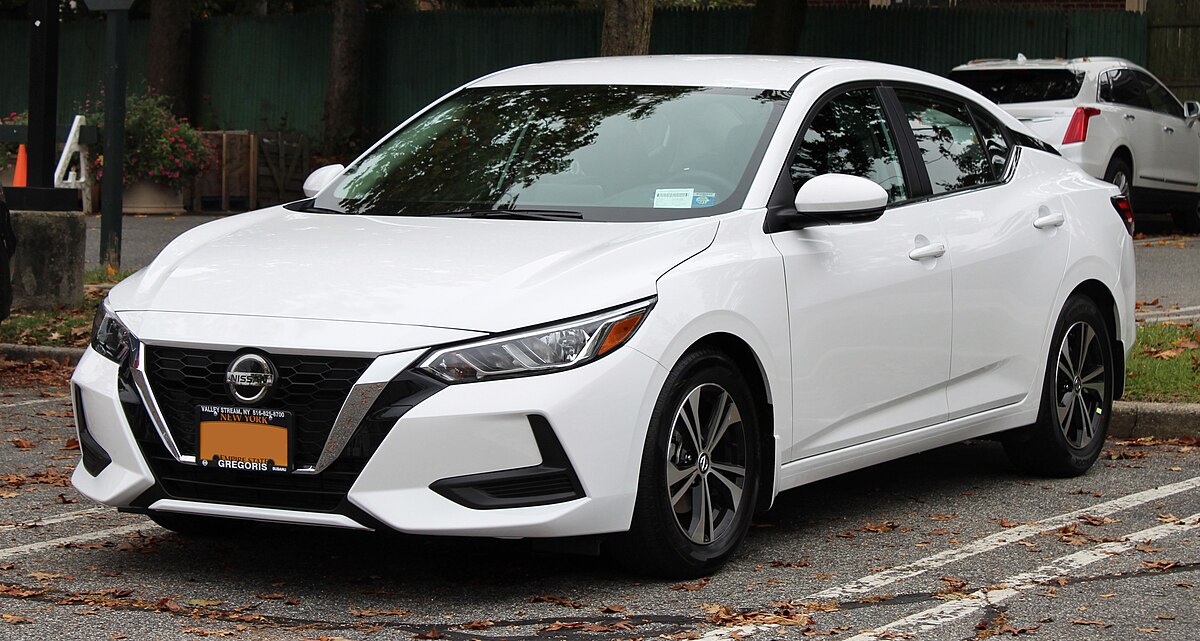
The loading lip sits at a comfortable height, reducing the effort required to lift heavy luggage into the cargo area. The trunk lid itself opens to a generous height, preventing taller users from having to stoop when accessing the cargo area a consideration often overlooked in competitive models.
Nissan enhances the Sentra’s versatility with 60/40 split-folding rear seats that expand the cargo capacity substantially when needed. These seats fold nearly flat with minimal effort, creating a continuous load floor that’s ideal for longer items or maximizing packing efficiency on extended trips.
The seat release mechanisms are accessible from the trunk itself a convenience that eliminates the need to walk around to the passenger compartment when loading longer items. The Sentra’s trunk incorporates numerous practical details that enhance its functionality for travelers.
Strategic lighting ensures visibility when loading or unloading at night, while the interior of the trunk is finished with durable materials that withstand the wear and tear associated with frequent loading and unloading of heavy items.
The trunk’s depth allows for vertical positioning of full-size suitcases a capability often lacking in compact vehicles that forces awkward horizontal placement.
Nissan has designed the Sentra’s trunk with thoughtful storage solutions that maximize organization. The side walls feature small compartments perfect for keeping smaller items secure and preventing them from sliding around during transit.
The trunk floor design allows for efficient utilization of the available space, with minimal intrusion from wheel wells or structural elements that might otherwise create awkward packing challenges. Despite its impressive cargo capacity, the Sentra maintains excellent fuel efficiency, a critical consideration for many compact car buyers.
This combination of practicality and economy makes it an ideal choice for those who regularly travel but don’t want the expense or parking challenges associated with larger vehicles. The Sentra’s competitive pricing further enhances its value proposition, offering premium cargo capacity without a premium price tag.
9. Chevrolet Cruze
The Chevrolet Cruze, though no longer in production as of the latest generation, deserves recognition for its exceptional cargo capacity that continues to make it a compelling option in the used car market.
With a trunk volume of 14.8 cubic feet in sedan form and an impressive 22.7 cubic feet behind the rear seats in the hatchback variant, the Cruze offers luggage space that rivals or exceeds many newer competitors.
This generous capacity transforms the compact Chevrolet from a modest commuter into a surprisingly versatile travel companion. What distinguishes the Cruze’s trunk is its thoughtfully engineered configuration.
General Motors’ designers created a cargo area with minimal intrusions and a wide, flat floor that accommodates multiple full-size suitcases with efficient space utilization.
In the sedan variant, the trunk’s dimensions have been carefully calculated to maximize usable space, with a depth that allows for strategic packing of luggage in various orientations.
The hatchback model takes this versatility to another level, with a square, boxy cargo area that maximizes every available cubic inch. The Cruze’s trunk opening deserves special mention, exceptionally wide for its class, it eliminates the common frustration of trying to angle bulky items through restrictive apertures.
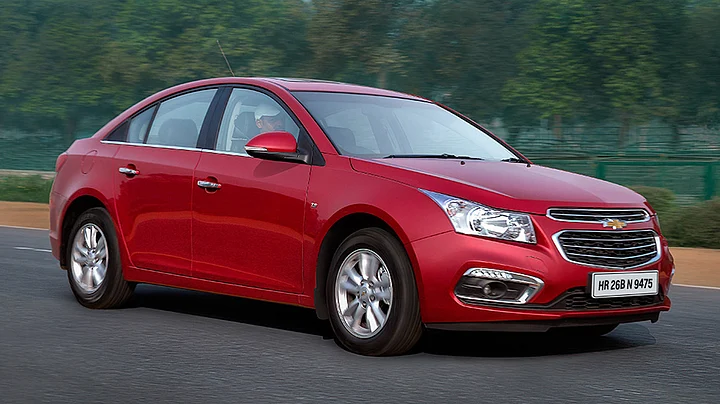
In the hatchback configuration, the large rear opening extends nearly to the bumper, creating a low lift-over height that reduces the effort required when loading heavy luggage.
This thoughtful design consideration demonstrates Chevrolet’s understanding of real-world usability rather than just impressive specification numbers. Chevrolet enhanced the Cruze’s versatility with 60/40 split-folding rear seats that expand the cargo capacity substantially when needed.
In the hatchback model, this configuration creates up to 47.2 cubic feet of cargo space, a figure that rivals some small SUVs. The seats fold nearly flat with minimal effort, creating a continuous load floor that’s ideal for longer items or maximizing packing efficiency on extended trips.
The transition between passenger and cargo configurations is seamless, requiring no complex mechanisms or removal of headrests. The Cruze’s trunk incorporates numerous practical details that enhance its functionality for travelers.
Strategic lighting ensures visibility when loading or unloading at night, while the interior of the trunk is finished with durable materials that withstand the wear and tear associated with frequent loading and unloading of heavy items.
In the hatchback variant, a retractable cargo cover comes standard, providing security and privacy for valuables, particularly important for travelers who might need to leave luggage in the vehicle temporarily.
Chevrolet designed the Cruze’s trunk with thoughtful storage solutions that maximize organization. The trunk floor conceals additional storage compartments perfect for keeping smaller items secure and preventing them from sliding around during transit.
These hidden spaces prove invaluable for storing valuables or emergency items that don’t need frequent access but should remain readily available when needed.
Despite its impressive cargo capacity, the Cruze maintains excellent fuel efficiency, a critical consideration for many compact car buyers. This combination of practicality and economy makes it an ideal choice for those who regularly travel but don’t want the expense or parking challenges associated with larger vehicles.
The Cruze’s widespread availability on the used market at competitive prices further enhances its value proposition, offering premium cargo capacity without a premium price tag.
10. Audi A3
The Audi A3 stands as compelling evidence that luxury and practicality need not be mutually exclusive in the compact car segment. Despite its premium positioning and sophisticated styling, the A3 sedan offers a surprisingly generous 12.3 cubic feet of trunk space, a figure that belies its sleek exterior proportions.
When considering the Sportback variant available in some markets, this capacity expands to an impressive 19.9 cubic feet behind the rear seats, rivaling many mainstream competitors.
What truly distinguishes the A3’s trunk is its thoughtfully engineered configuration. Audi’s designers have created a cargo area with minimal intrusions and a wide, flat floor that accommodates full-size luggage with remarkable efficiency.
The trunk’s dimensions have been carefully calculated to maximize usable space, with a depth that allows for strategic packing of suitcases in various orientations.
This attention to spatial optimization reflects Audi’s commitment to delivering practical functionality alongside luxury appointments. The A3’s trunk opening deserves special recognition, exceptionally wide for a vehicle in its class, it eliminates the common frustration of trying to angle bulky items through restrictive apertures.
The loading lip sits at a comfortable height, reducing the effort required to lift heavy luggage into the cargo area. In the Sportback configuration, the large rear opening extends nearly to the bumper, creating a low lift-over height that further enhances loading convenience.
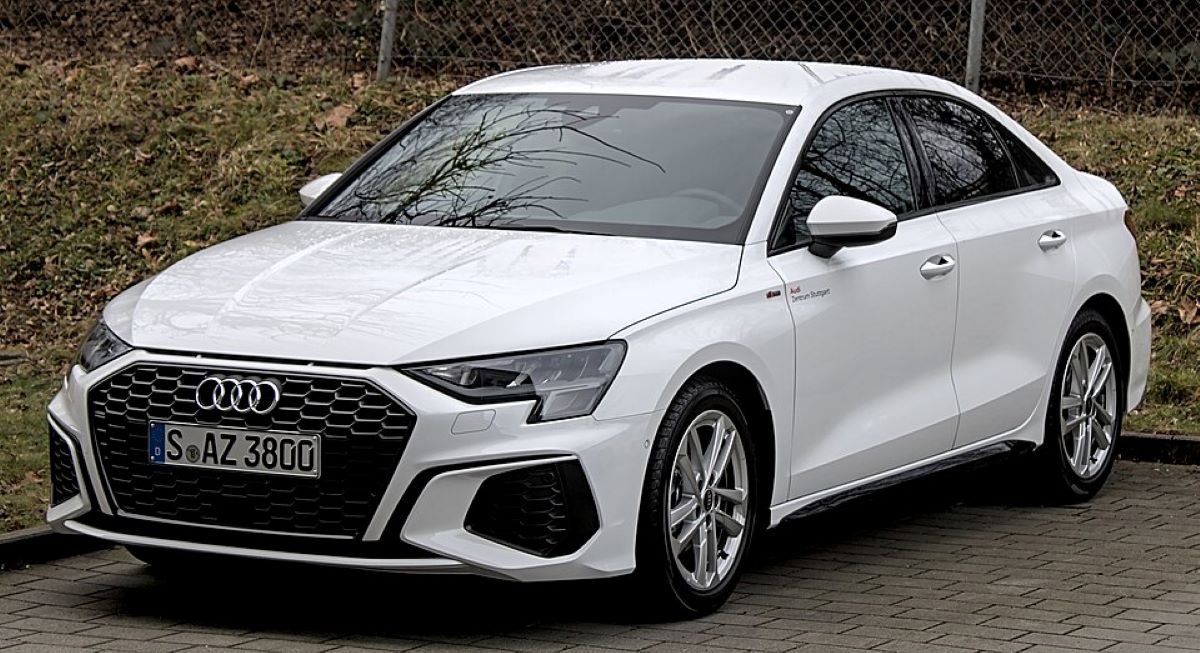
These thoughtful design considerations demonstrate Audi’s understanding of real-world usability rather than just impressive specification numbers.
Audi enhances the A3’s versatility with 40/20/40 split-folding rear seats a more flexible arrangement than the typical 60/40 split found in many competitors.
This configuration allows for various combinations of passengers and cargo, including the ability to carry long items like skis while still accommodating two rear passengers.
The seats fold nearly flat with minimal effort, creating a continuous load floor that’s ideal for longer items or maximizing packing efficiency on extended trips.
In the Sportback variant, this expanded configuration creates up to 43.1 cubic feet of cargo space an impressive figure for a vehicle in this class. The A3’s trunk incorporates numerous premium details that elevate its functionality beyond mere spatial dimensions.
Strategic LED lighting ensures optimal visibility when loading or unloading at night, while the interior of the trunk is finished with high-quality materials that maintain the vehicle’s luxury aesthetic.
In the Sportback variant, a power-operated tailgate is available, providing hands-free access when approaching the vehicle with arms full of luggage a convenience particularly appreciated in inclement weather.
Audi has designed the A3’s trunk with thoughtful storage solutions that maximize organization. The trunk floor features a multi-level design that can be positioned to create separate compartments or a flat load floor when the rear seats are folded.
Integrated tie-down points prevent items from shifting during transit, while cargo nets and dividers are available as accessories to further enhance organization.
These refinements elevate the ownership experience and demonstrate Audi’s understanding that cargo functionality involves more than just raw volume.
Despite its impressive cargo capacity, the A3 maintains the driving dynamics and refined road manners expected from a premium German marque.
This combination of practicality and driving enjoyment makes it an exceptional choice for those who require substantial luggage capacity but aren’t willing to compromise on luxury appointments or driving experience.
The A3 proves that downsizing to a compact car need not mean sacrificing either sophistication or utility a compelling proposition for discerning buyers.
Also Read: Top Engines That Can Survive Without a Working Cooling Fan

